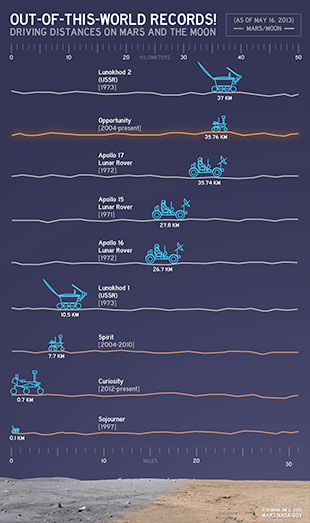May 18, 2013 — A robotic rover on Mars has rolled past a record set by the last men to walk on the moon more than 40 years ago.
The team operating Opportunity, one of NASA's twin Mars Exploration Rovers, received confirmation from the Red Planet on Thursday (May 16) that the golf-cart size rover had driven past the 22.21 miles (35.74 kilometers) logged by the Apollo 17 astronauts riding their lunar roving vehicle (LRV) in December 1972.
Opportunity, which landed on Mars in January 2004, took nine years to travel the same distance that Gene Cernan and Harrison Schmitt covered over the course of just three days. Until Thursday, the Apollo 17 moonwalkers held the record for the farthest total distance traveled on or by any NASA wheeled vehicle driving on a world other than Earth.
"The record we established with a roving vehicle was made to be broken," Cernan told Jim Rice, an Opportunity team member at NASA's Goddard Space Flight Center in Greenbelt, Maryland, a few days before the rover passed the astronaut's driving distance. "I'm excited and proud to be able to pass the torch to Opportunity."
The international record for rolling across another world is still held by the Soviet Union's remote-controlled Lunokhod 2 rover, which traversed 23 miles (37 kilometers) on the surface of Earth's moon in 1973.
Opportunity just embarked on a multi-week trek that may soon put the Lunokhod record in its rear-view mirror, too. The six-wheeled rover departed an area where it has been working since mid-2011, the "Cape York" segment of the rim of Mars' Endeavour Crater, to reach an area about 1.4 miles (2.2 kilometers) away, known as "Solander Point."
"I want to beat that record," John Callas, project manager for the Opportunity rover at the Jet Propulsion Laboratory in Pasadena, Calif., told SPACE.com last year.

This chart (click image to enlarge) illustrates distances driven by various wheeled vehicles on the surface of the moon and Mars. |
Opportunity and its twin, Spirit, originally touched down on Mars on three-month missions to search for signs of past water activity on the Red Planet. Both rovers found plenty of such evidence, then kept on roving.
Spirit stopped communicating with Earth in 2010 and was declared dead a year later. It traveled a total of 4.8 miles (7.7 kilometers).
The Apollo 17 LRV was the third U.S. lunar rover sent to the moon. The vehicles driven by astronauts on the Apollo 15 and Apollo 16 missions trail the Apollo 17 buggy by 4.9 and 5.6 miles (7.9 and 9.04 kilometers) respectively, but still surpass all of the robotic rovers sent to the moon and Mars other than Lunokhod 2.
Original reporting by SPACE.com's senior writer Mike Wall was adapted for this article.
